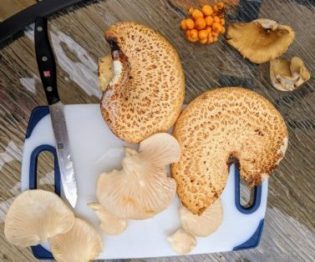With a few hours to kill in Michigan earlier this spring, I headed out to scope some new territory. While I was hoping to add to the small, aged morel cache from earlier in the week, I settled instead for a few oyster mushrooms and dryad’s saddle, also known as pheasant backs.
 Pheasant backs are interesting. They have both the aroma and a slight flavor of cucumber. Since I don’t like cucumber (but love pickles, go figure) I wasn’t entirely sure I’d like them.
Pheasant backs are interesting. They have both the aroma and a slight flavor of cucumber. Since I don’t like cucumber (but love pickles, go figure) I wasn’t entirely sure I’d like them.
But, once I’d cleaned the pores off the bottom and sliced them thin and cooked them the taste didn’t bother me greatly. I can imagine they’d be tasty pickled.
Still, my last attempt at pheasant backs was mediocre. I sliced them thin and sautéed then briefly, then threw them into a ramen. Unfortunately, they were too green tasting to suit that dish, or to suit the broth I was using. So, on this night, I sautéed both the oysters and the shaved pheasant backs with butter and a hint of garlic and some soy sauce instead.

The results were terrible. While the oyster mushrooms were perfect, delicious, and assumed some of the umami flavors of the soy, the dryad’s saddle did not fare so well. To be edible, pheasant backs must be shaved thin and, ideally poached or cooked in water, as The Forager Chef advises. What I got out of my sautéed pheasant backs was tin-metal tough. I think eating leather would have been better.
So, dryad’s saddle one; this forager, zero. At least the oyster mushrooms were tasty.

The other thing to know about pheasant backs that might be helpful, and that I discuss in my intro article on them is that you need to be able to remove the pores easily. I do something I call the scratch test. If you can scratch with your nail on the underside with the pores, and they remove easily, you have a good one. I generally only harvest these to eat in the Spring around when I pick morels, I don’t even give them a second glance in the Summer. It’s not the mushrooms fault they’re tough as they age, you just need to get young mushrooms to have them be tender.
Interesting, Alan, thanks for this. I’ve found that using the back of my knife helps with removing the pores, but I’m definitely going to try again with the younger ones next spring. And also, maybe try pickling.